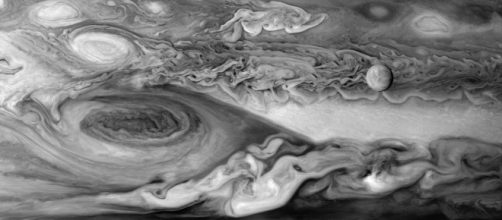After having being launches into space five years ago on august 5, 2011, NASA´s Juno Spacecraft was locked into an orbit around the gas giant planet-Jupiter. Jun is planned to conduct Science research on Jupiter´s atmosphere, its interior and the gravitational and magnetic fields. Jupiter Is believed to have influenced 6the formation of the near earth solar system and it´s believed that understanding in depth the way in which it was formed and evolved will help scientists understand the whole process of formation of the entire solar system and beyond.
Earlier missions
The first attempts to understand the processes occurring in the biggest planet in the solar system began early in the 70s when the first missions with this purpose were sent into space and in the direction of the gas giant planet. The first close-up images and observations of Jupiter were accomplished in late 1973 and early 1974 by Pioneer 10 and 11. They did not only peek at the gas giant, but also to its moons and the most noticeable feature on its surface. The Great Red Spot.
First findings
Derived from the Pioneer´s observations, it was found that Jupiter was composed of gas and that it had a magneto tail, similar to earth´s. This allowed to deduced Jupiter’s composition and possibly a solid core in its interior.
Voyager 1 and 2 were launched in 1977 and both flew past Jupiter in 1979, taking over 52,000 pictures of Jupiter and its moons. They revealed new features, such as hurricanes and lightning on its cloud tops. The images also disclosed the existence of volcanoes, which until then, were only known to exist on earth.
The Galileo missions, one of which was a probe and the other an orbiter, in the late 1080s were designed to orbit the gas giant planet.
The probe measure characteristics of Jupiter´s atmosphere by descending through Jupiter´s atmosphere after which it melted and vaporized due to the extreme heat. The orbiter was able to discover water on Europa-one of Jupiter´s Galilean moon. It also discovered Jupiter ring system and witness the impact of comet Shoemaker: Levy 9 into Jupiter’s atmosphere.
In 1992, the Ulysses mission observed and collected data about the magnetosphere of Jupiter while it approached the planet for a gravitational assist that would projected in the direction of the sun. On its way to Saturn, the Cassini spacecraft took over 20,000 pictures of Jupiter and its moons. New Horizons, a spacecraft planned on a mission to Pluto, flyby Jupiter in 2007 and during a six months observation of the planet, it explored weather systems, Jupiter´s moons and rings and the Great Red Spot. It observed over 30 volcanoes son Id-the most volcanically active astronomical object in the solar system.
Juno mission
Juno mission is expected to conduct science observations of Jupiter in September 2016.
Several images taken by JunoCam have already being released. This mission is planned to conduct observations of Jupiter´s atmosphere and its magnetic and gravitational fields, revealing in depth information about the gas giant structure. Scientists expect to broaden their understanding about the formation and evolution of Jupiter, as well as the solar system.

